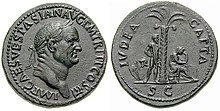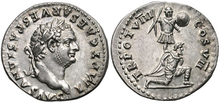



Judaea Capta coins (also spelled Judea Capta, and, on many of the coins, IVDAEA CAPTA) were a series of commemorative coins originally issued by the Roman Emperor Vespasian to celebrate the capture of Judaea and the destruction of the Second Jewish Temple by his son Titus in 70 CE during the First Jewish Revolt. There are several variants of the coinage. The reverse of the coins may show a female seated right in an attitude of mourning at the base of a palm tree, with either a captive bearded male standing left, with his hands bound behind his back, or the standing figure of the victorious emperor, or the goddess Victoria, with a trophy of weapons, shields, and helmets to the left.
At the bottom of some coins appear the initials SC which stand for Senatus Consulto 'by decree of the senate' - the emperor controlled gold and silver coins, and copper alloy coins were controlled by the senate to guarantee their value.[1][2]
- ^ "How to read a Roman coin, from the Malpas and Knutsford hoards". National Museums Liverpool. Retrieved 2022-04-23.
- ^ "Coin Value: Ancient Rome Coins with S C Annotation 27BC to 376AD". coinquest.com. Retrieved 2022-04-23.